Comprehensive Risk Analysis and Management in Real Estate Business
VerifiedAdded on 2020/02/14
|7
|1722
|66
Report
AI Summary
This report provides a detailed analysis of risk management within the real estate sector, specifically focusing on the practices of Stockland, a prominent real estate company. The report begins with an introduction to the concept of risk and the importance of effective risk management processes in identifying, assessing, and mitigating potential threats and uncertainties. The main body delves into the various types of risks prevalent in the real estate sector, including staff safety risks (accidental and technical), agency-related risks (credit and market), and risks associated with customers and clients (illegal activities and misuse of documents). The report also explores risk assessment methodologies, such as the Capital Assets Pricing Model (CAPM) and Probabilistic Risk Assessment (PRA), and discusses the stages involved in a comprehensive risk management process: identifying risks, analyzing them, evaluating and ranking hazards, and treating dangers. The report emphasizes the importance of systematic risk management plans and the use of risk assessment methods to determine risk factors and their solutions. Furthermore, it highlights the need for insurance and financial strategies to minimize potential losses and maximize opportunities. The report concludes with a reference list of relevant books, journals, and online resources to support the analysis.
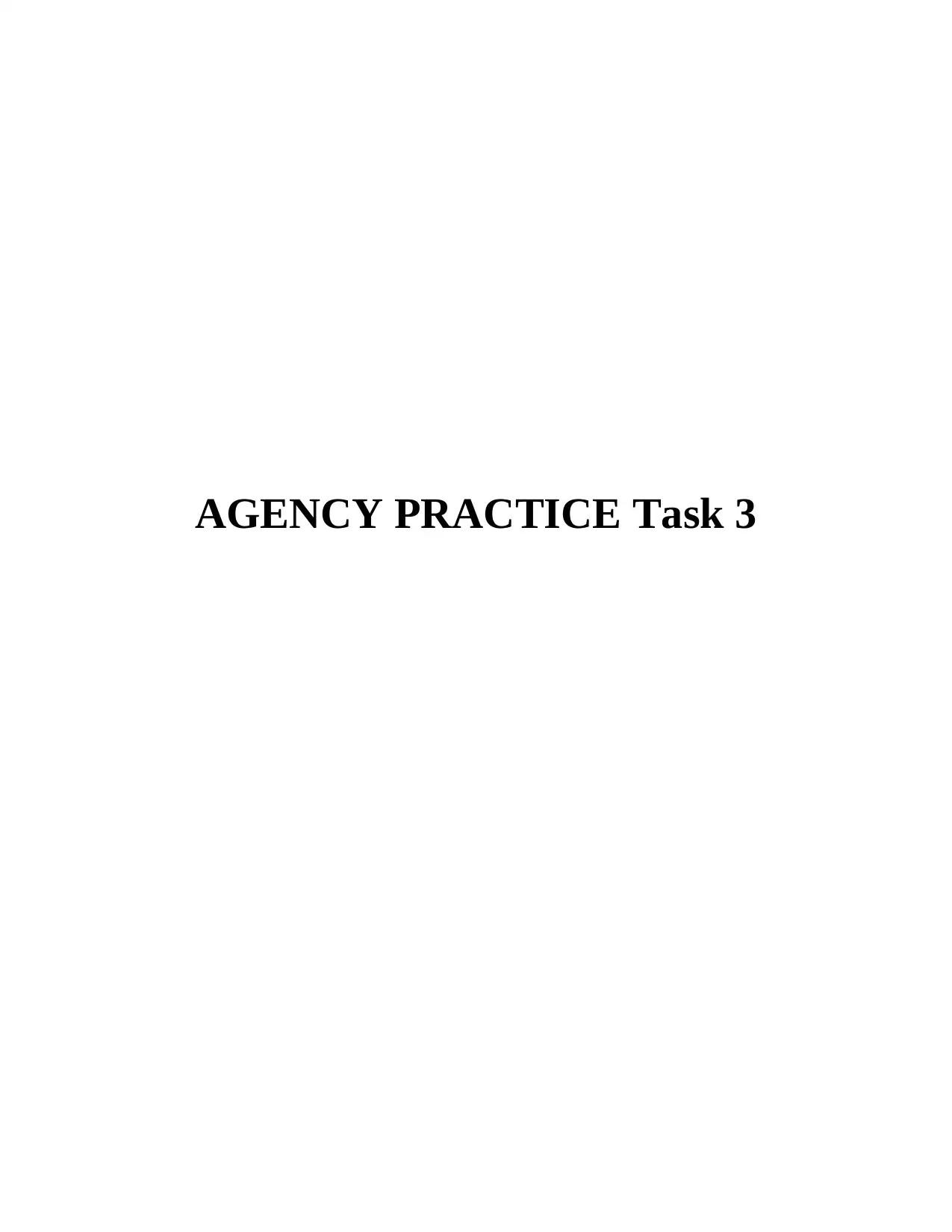
AGENCY PRACTICE Task 3
Paraphrase This Document
Need a fresh take? Get an instant paraphrase of this document with our AI Paraphraser
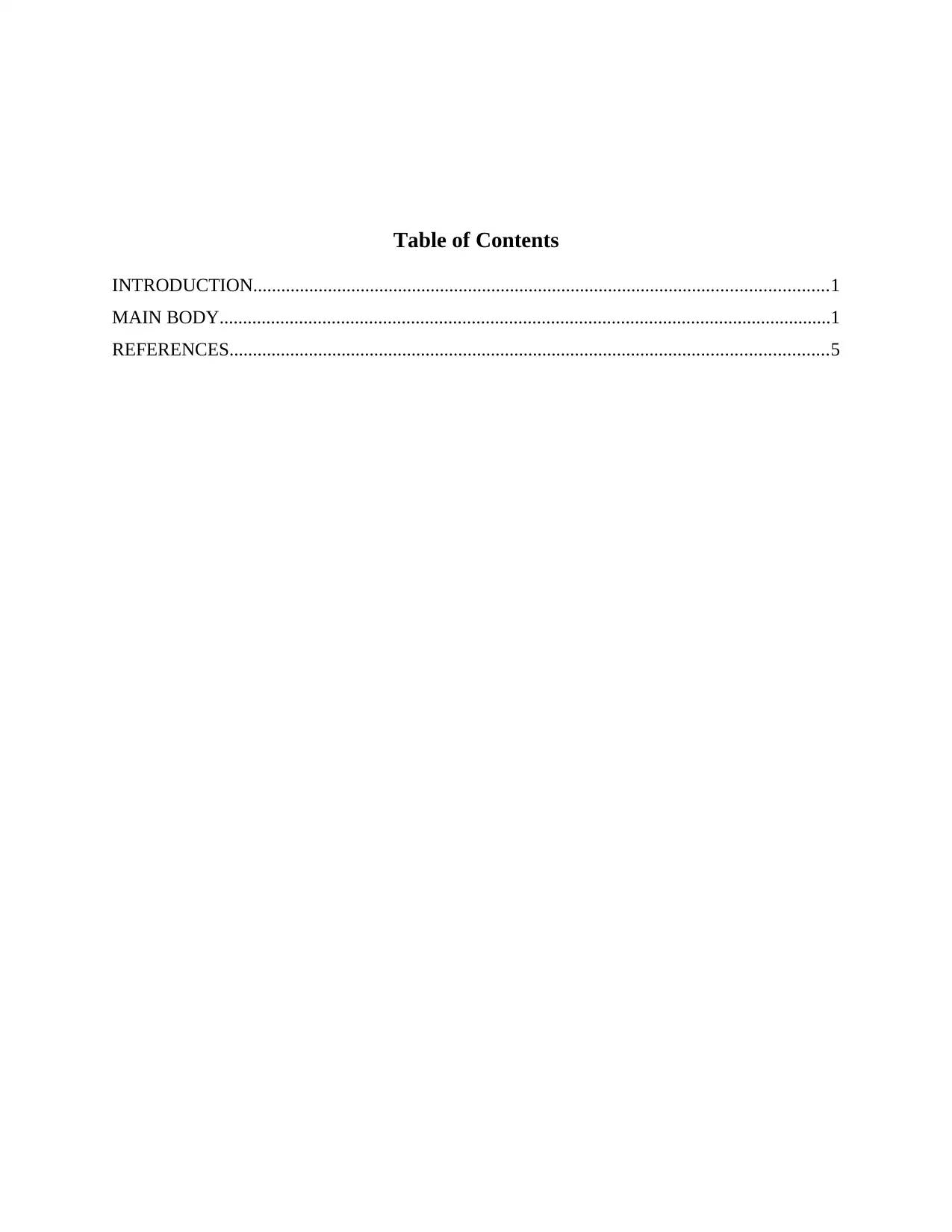
Table of Contents
INTRODUCTION...........................................................................................................................1
MAIN BODY...................................................................................................................................1
REFERENCES................................................................................................................................5
INTRODUCTION...........................................................................................................................1
MAIN BODY...................................................................................................................................1
REFERENCES................................................................................................................................5
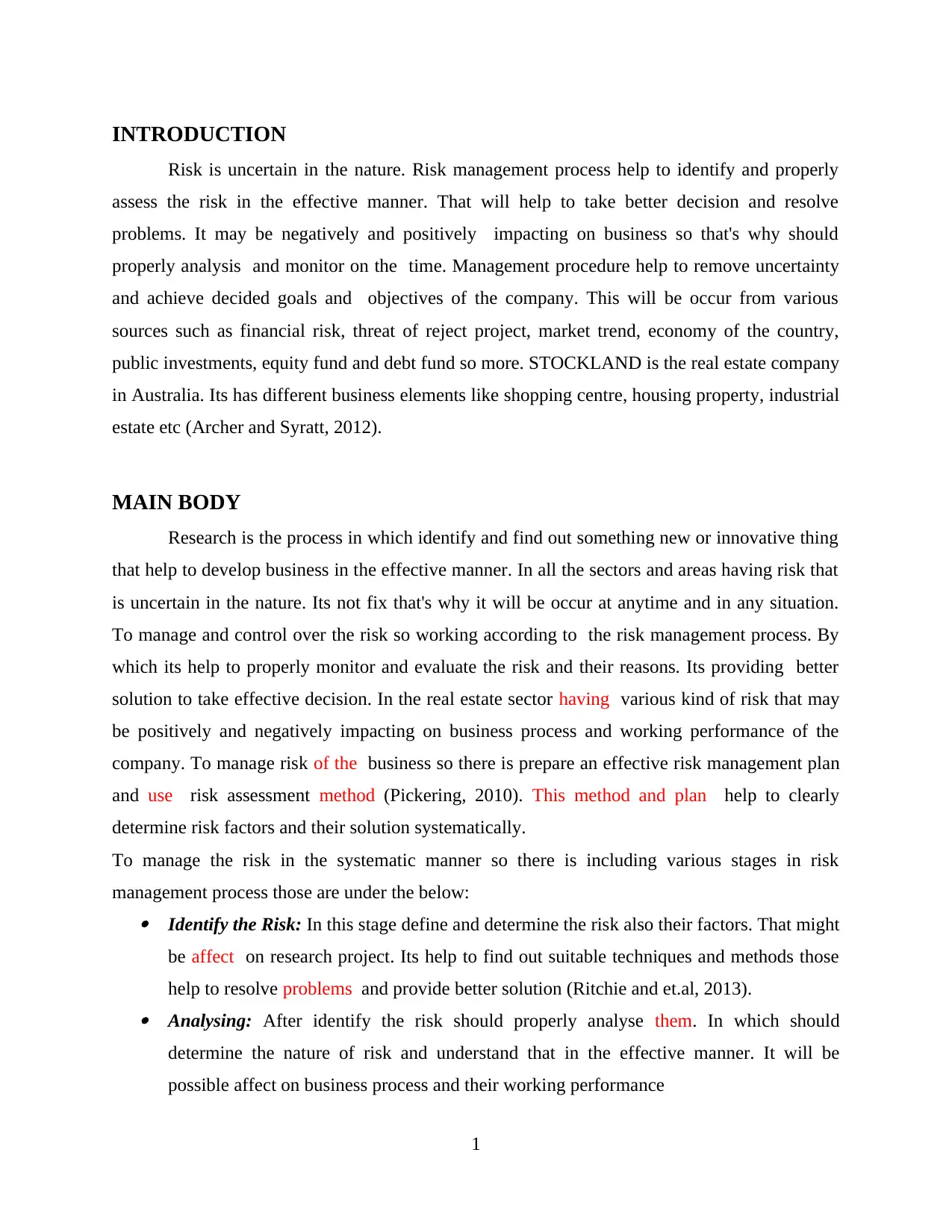
INTRODUCTION
Risk is uncertain in the nature. Risk management process help to identify and properly
assess the risk in the effective manner. That will help to take better decision and resolve
problems. It may be negatively and positively impacting on business so that's why should
properly analysis and monitor on the time. Management procedure help to remove uncertainty
and achieve decided goals and objectives of the company. This will be occur from various
sources such as financial risk, threat of reject project, market trend, economy of the country,
public investments, equity fund and debt fund so more. STOCKLAND is the real estate company
in Australia. Its has different business elements like shopping centre, housing property, industrial
estate etc (Archer and Syratt, 2012).
MAIN BODY
Research is the process in which identify and find out something new or innovative thing
that help to develop business in the effective manner. In all the sectors and areas having risk that
is uncertain in the nature. Its not fix that's why it will be occur at anytime and in any situation.
To manage and control over the risk so working according to the risk management process. By
which its help to properly monitor and evaluate the risk and their reasons. Its providing better
solution to take effective decision. In the real estate sector having various kind of risk that may
be positively and negatively impacting on business process and working performance of the
company. To manage risk of the business so there is prepare an effective risk management plan
and use risk assessment method (Pickering, 2010). This method and plan help to clearly
determine risk factors and their solution systematically.
To manage the risk in the systematic manner so there is including various stages in risk
management process those are under the below: Identify the Risk: In this stage define and determine the risk also their factors. That might
be affect on research project. Its help to find out suitable techniques and methods those
help to resolve problems and provide better solution (Ritchie and et.al, 2013). Analysing: After identify the risk should properly analyse them. In which should
determine the nature of risk and understand that in the effective manner. It will be
possible affect on business process and their working performance
1
Risk is uncertain in the nature. Risk management process help to identify and properly
assess the risk in the effective manner. That will help to take better decision and resolve
problems. It may be negatively and positively impacting on business so that's why should
properly analysis and monitor on the time. Management procedure help to remove uncertainty
and achieve decided goals and objectives of the company. This will be occur from various
sources such as financial risk, threat of reject project, market trend, economy of the country,
public investments, equity fund and debt fund so more. STOCKLAND is the real estate company
in Australia. Its has different business elements like shopping centre, housing property, industrial
estate etc (Archer and Syratt, 2012).
MAIN BODY
Research is the process in which identify and find out something new or innovative thing
that help to develop business in the effective manner. In all the sectors and areas having risk that
is uncertain in the nature. Its not fix that's why it will be occur at anytime and in any situation.
To manage and control over the risk so working according to the risk management process. By
which its help to properly monitor and evaluate the risk and their reasons. Its providing better
solution to take effective decision. In the real estate sector having various kind of risk that may
be positively and negatively impacting on business process and working performance of the
company. To manage risk of the business so there is prepare an effective risk management plan
and use risk assessment method (Pickering, 2010). This method and plan help to clearly
determine risk factors and their solution systematically.
To manage the risk in the systematic manner so there is including various stages in risk
management process those are under the below: Identify the Risk: In this stage define and determine the risk also their factors. That might
be affect on research project. Its help to find out suitable techniques and methods those
help to resolve problems and provide better solution (Ritchie and et.al, 2013). Analysing: After identify the risk should properly analyse them. In which should
determine the nature of risk and understand that in the effective manner. It will be
possible affect on business process and their working performance
1
⊘ This is a preview!⊘
Do you want full access?
Subscribe today to unlock all pages.

Trusted by 1+ million students worldwide
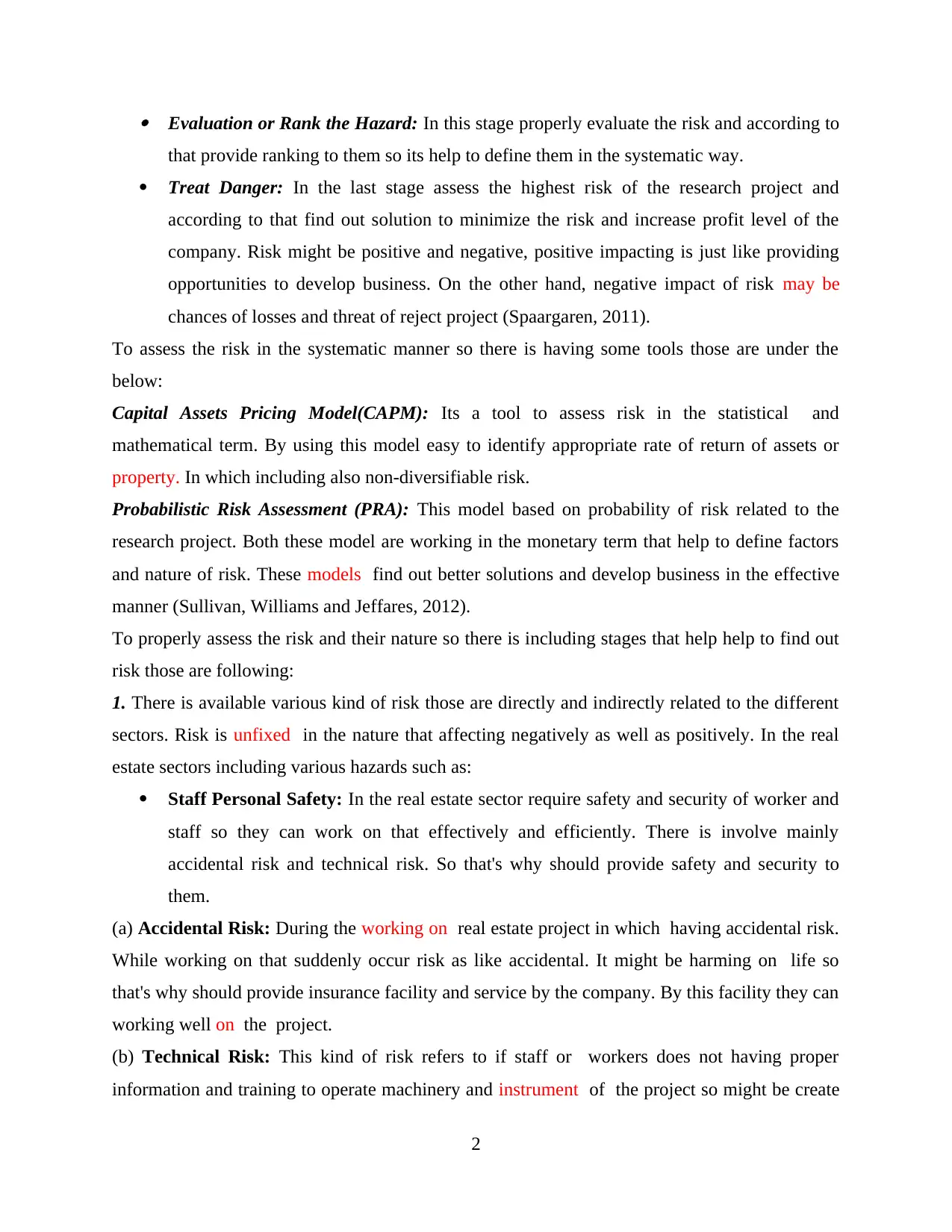
Evaluation or Rank the Hazard: In this stage properly evaluate the risk and according to
that provide ranking to them so its help to define them in the systematic way.
Treat Danger: In the last stage assess the highest risk of the research project and
according to that find out solution to minimize the risk and increase profit level of the
company. Risk might be positive and negative, positive impacting is just like providing
opportunities to develop business. On the other hand, negative impact of risk may be
chances of losses and threat of reject project (Spaargaren, 2011).
To assess the risk in the systematic manner so there is having some tools those are under the
below:
Capital Assets Pricing Model(CAPM): Its a tool to assess risk in the statistical and
mathematical term. By using this model easy to identify appropriate rate of return of assets or
property. In which including also non-diversifiable risk.
Probabilistic Risk Assessment (PRA): This model based on probability of risk related to the
research project. Both these model are working in the monetary term that help to define factors
and nature of risk. These models find out better solutions and develop business in the effective
manner (Sullivan, Williams and Jeffares, 2012).
To properly assess the risk and their nature so there is including stages that help help to find out
risk those are following:
1. There is available various kind of risk those are directly and indirectly related to the different
sectors. Risk is unfixed in the nature that affecting negatively as well as positively. In the real
estate sectors including various hazards such as:
Staff Personal Safety: In the real estate sector require safety and security of worker and
staff so they can work on that effectively and efficiently. There is involve mainly
accidental risk and technical risk. So that's why should provide safety and security to
them.
(a) Accidental Risk: During the working on real estate project in which having accidental risk.
While working on that suddenly occur risk as like accidental. It might be harming on life so
that's why should provide insurance facility and service by the company. By this facility they can
working well on the project.
(b) Technical Risk: This kind of risk refers to if staff or workers does not having proper
information and training to operate machinery and instrument of the project so might be create
2
that provide ranking to them so its help to define them in the systematic way.
Treat Danger: In the last stage assess the highest risk of the research project and
according to that find out solution to minimize the risk and increase profit level of the
company. Risk might be positive and negative, positive impacting is just like providing
opportunities to develop business. On the other hand, negative impact of risk may be
chances of losses and threat of reject project (Spaargaren, 2011).
To assess the risk in the systematic manner so there is having some tools those are under the
below:
Capital Assets Pricing Model(CAPM): Its a tool to assess risk in the statistical and
mathematical term. By using this model easy to identify appropriate rate of return of assets or
property. In which including also non-diversifiable risk.
Probabilistic Risk Assessment (PRA): This model based on probability of risk related to the
research project. Both these model are working in the monetary term that help to define factors
and nature of risk. These models find out better solutions and develop business in the effective
manner (Sullivan, Williams and Jeffares, 2012).
To properly assess the risk and their nature so there is including stages that help help to find out
risk those are following:
1. There is available various kind of risk those are directly and indirectly related to the different
sectors. Risk is unfixed in the nature that affecting negatively as well as positively. In the real
estate sectors including various hazards such as:
Staff Personal Safety: In the real estate sector require safety and security of worker and
staff so they can work on that effectively and efficiently. There is involve mainly
accidental risk and technical risk. So that's why should provide safety and security to
them.
(a) Accidental Risk: During the working on real estate project in which having accidental risk.
While working on that suddenly occur risk as like accidental. It might be harming on life so
that's why should provide insurance facility and service by the company. By this facility they can
working well on the project.
(b) Technical Risk: This kind of risk refers to if staff or workers does not having proper
information and training to operate machinery and instrument of the project so might be create
2
Paraphrase This Document
Need a fresh take? Get an instant paraphrase of this document with our AI Paraphraser
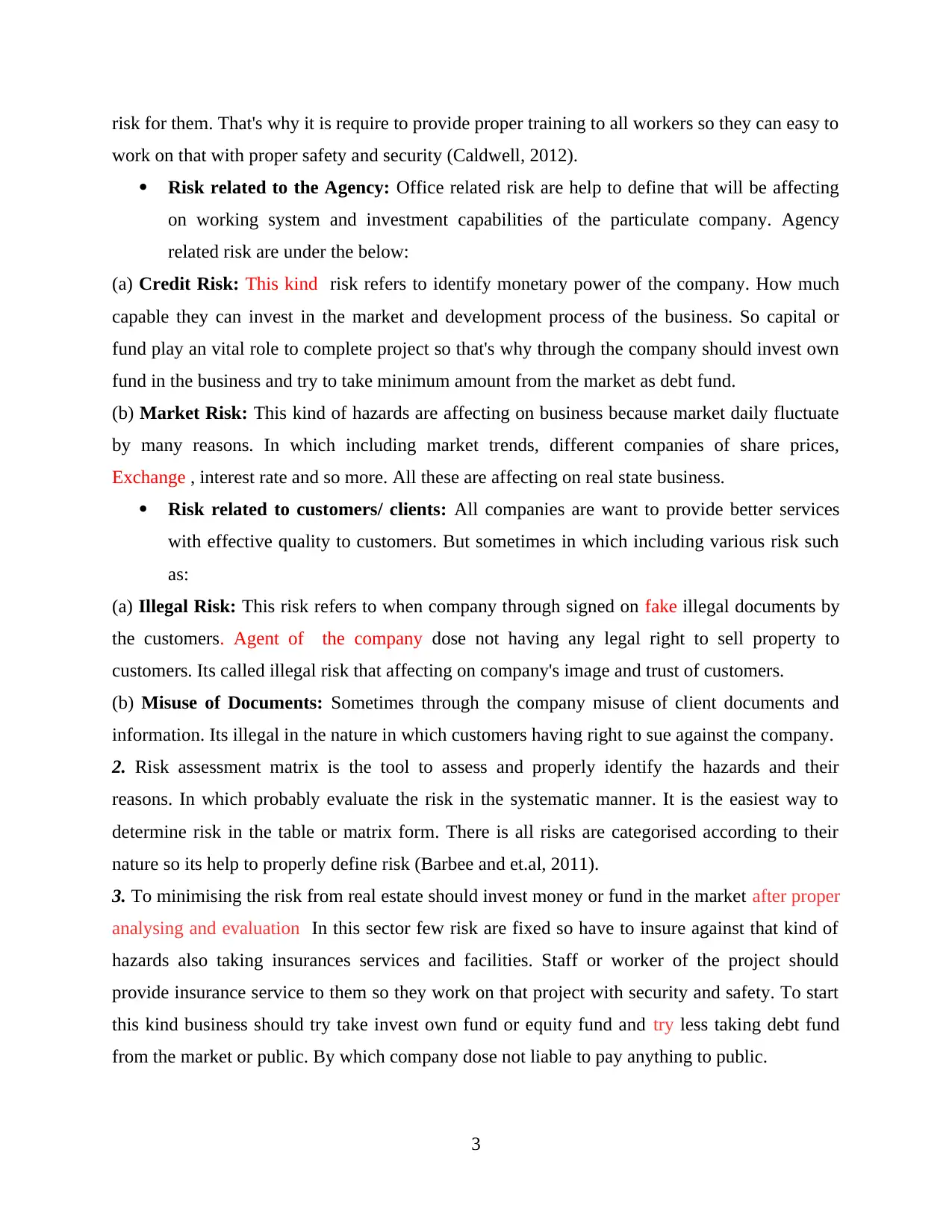
risk for them. That's why it is require to provide proper training to all workers so they can easy to
work on that with proper safety and security (Caldwell, 2012).
Risk related to the Agency: Office related risk are help to define that will be affecting
on working system and investment capabilities of the particulate company. Agency
related risk are under the below:
(a) Credit Risk: This kind risk refers to identify monetary power of the company. How much
capable they can invest in the market and development process of the business. So capital or
fund play an vital role to complete project so that's why through the company should invest own
fund in the business and try to take minimum amount from the market as debt fund.
(b) Market Risk: This kind of hazards are affecting on business because market daily fluctuate
by many reasons. In which including market trends, different companies of share prices,
Exchange , interest rate and so more. All these are affecting on real state business.
Risk related to customers/ clients: All companies are want to provide better services
with effective quality to customers. But sometimes in which including various risk such
as:
(a) Illegal Risk: This risk refers to when company through signed on fake illegal documents by
the customers. Agent of the company dose not having any legal right to sell property to
customers. Its called illegal risk that affecting on company's image and trust of customers.
(b) Misuse of Documents: Sometimes through the company misuse of client documents and
information. Its illegal in the nature in which customers having right to sue against the company.
2. Risk assessment matrix is the tool to assess and properly identify the hazards and their
reasons. In which probably evaluate the risk in the systematic manner. It is the easiest way to
determine risk in the table or matrix form. There is all risks are categorised according to their
nature so its help to properly define risk (Barbee and et.al, 2011).
3. To minimising the risk from real estate should invest money or fund in the market after proper
analysing and evaluation In this sector few risk are fixed so have to insure against that kind of
hazards also taking insurances services and facilities. Staff or worker of the project should
provide insurance service to them so they work on that project with security and safety. To start
this kind business should try take invest own fund or equity fund and try less taking debt fund
from the market or public. By which company dose not liable to pay anything to public.
3
work on that with proper safety and security (Caldwell, 2012).
Risk related to the Agency: Office related risk are help to define that will be affecting
on working system and investment capabilities of the particulate company. Agency
related risk are under the below:
(a) Credit Risk: This kind risk refers to identify monetary power of the company. How much
capable they can invest in the market and development process of the business. So capital or
fund play an vital role to complete project so that's why through the company should invest own
fund in the business and try to take minimum amount from the market as debt fund.
(b) Market Risk: This kind of hazards are affecting on business because market daily fluctuate
by many reasons. In which including market trends, different companies of share prices,
Exchange , interest rate and so more. All these are affecting on real state business.
Risk related to customers/ clients: All companies are want to provide better services
with effective quality to customers. But sometimes in which including various risk such
as:
(a) Illegal Risk: This risk refers to when company through signed on fake illegal documents by
the customers. Agent of the company dose not having any legal right to sell property to
customers. Its called illegal risk that affecting on company's image and trust of customers.
(b) Misuse of Documents: Sometimes through the company misuse of client documents and
information. Its illegal in the nature in which customers having right to sue against the company.
2. Risk assessment matrix is the tool to assess and properly identify the hazards and their
reasons. In which probably evaluate the risk in the systematic manner. It is the easiest way to
determine risk in the table or matrix form. There is all risks are categorised according to their
nature so its help to properly define risk (Barbee and et.al, 2011).
3. To minimising the risk from real estate should invest money or fund in the market after proper
analysing and evaluation In this sector few risk are fixed so have to insure against that kind of
hazards also taking insurances services and facilities. Staff or worker of the project should
provide insurance service to them so they work on that project with security and safety. To start
this kind business should try take invest own fund or equity fund and try less taking debt fund
from the market or public. By which company dose not liable to pay anything to public.
3
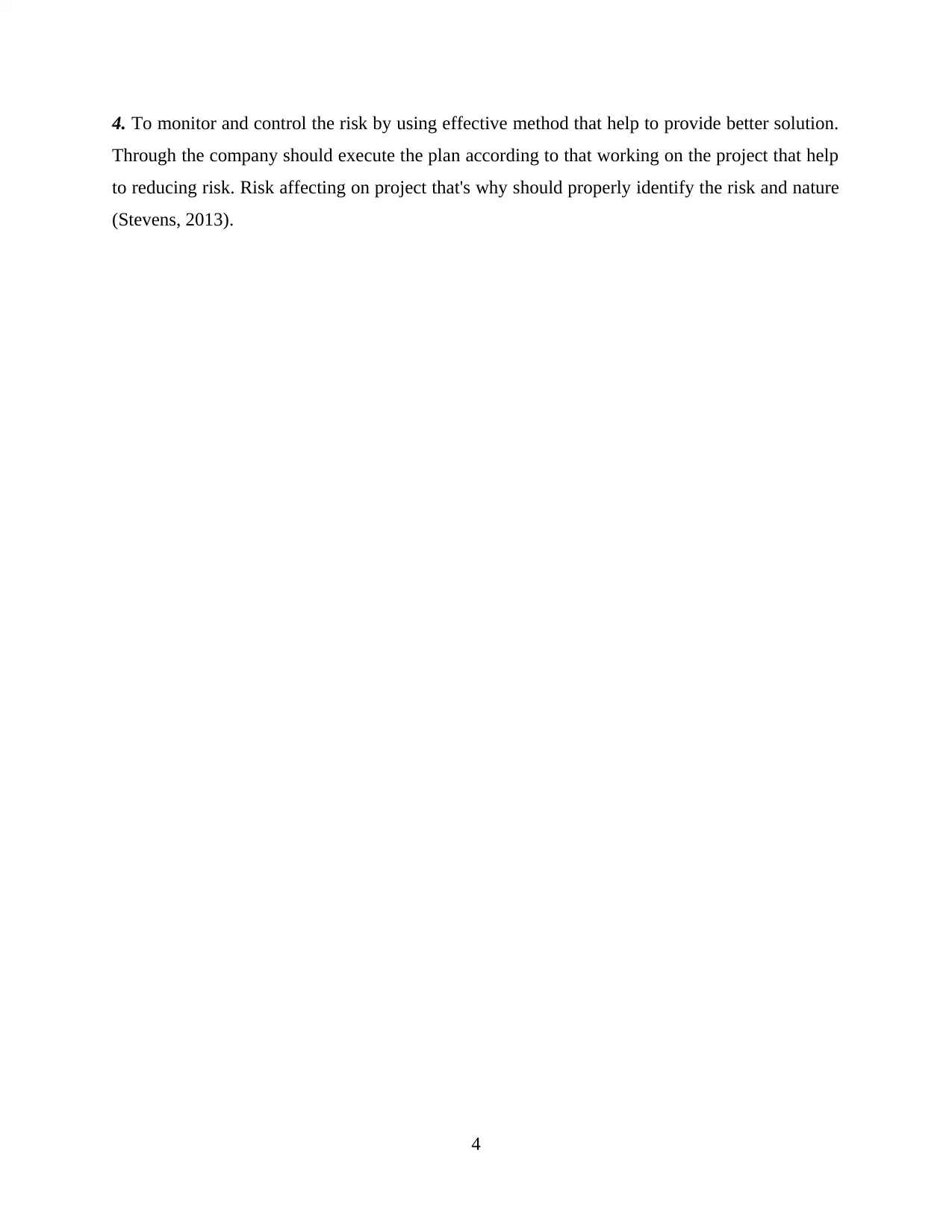
4. To monitor and control the risk by using effective method that help to provide better solution.
Through the company should execute the plan according to that working on the project that help
to reducing risk. Risk affecting on project that's why should properly identify the risk and nature
(Stevens, 2013).
4
Through the company should execute the plan according to that working on the project that help
to reducing risk. Risk affecting on project that's why should properly identify the risk and nature
(Stevens, 2013).
4
⊘ This is a preview!⊘
Do you want full access?
Subscribe today to unlock all pages.

Trusted by 1+ million students worldwide
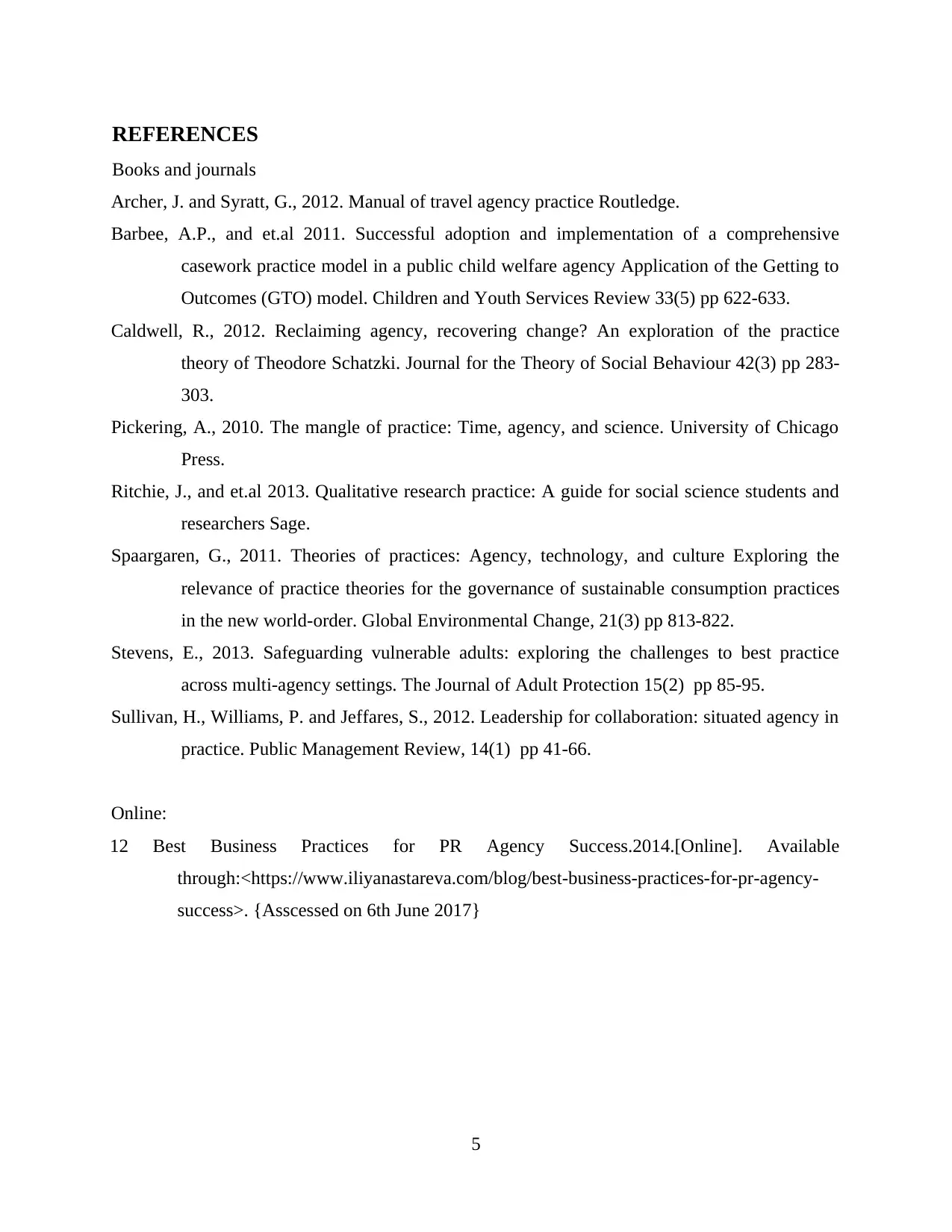
REFERENCES
Books and journals
Archer, J. and Syratt, G., 2012. Manual of travel agency practice Routledge.
Barbee, A.P., and et.al 2011. Successful adoption and implementation of a comprehensive
casework practice model in a public child welfare agency Application of the Getting to
Outcomes (GTO) model. Children and Youth Services Review 33(5) pp 622-633.
Caldwell, R., 2012. Reclaiming agency, recovering change? An exploration of the practice
theory of Theodore Schatzki. Journal for the Theory of Social Behaviour 42(3) pp 283-
303.
Pickering, A., 2010. The mangle of practice: Time, agency, and science. University of Chicago
Press.
Ritchie, J., and et.al 2013. Qualitative research practice: A guide for social science students and
researchers Sage.
Spaargaren, G., 2011. Theories of practices: Agency, technology, and culture Exploring the
relevance of practice theories for the governance of sustainable consumption practices
in the new world-order. Global Environmental Change, 21(3) pp 813-822.
Stevens, E., 2013. Safeguarding vulnerable adults: exploring the challenges to best practice
across multi-agency settings. The Journal of Adult Protection 15(2) pp 85-95.
Sullivan, H., Williams, P. and Jeffares, S., 2012. Leadership for collaboration: situated agency in
practice. Public Management Review, 14(1) pp 41-66.
Online:
12 Best Business Practices for PR Agency Success.2014.[Online]. Available
through:<https://www.iliyanastareva.com/blog/best-business-practices-for-pr-agency-
success>. {Asscessed on 6th June 2017}
5
Books and journals
Archer, J. and Syratt, G., 2012. Manual of travel agency practice Routledge.
Barbee, A.P., and et.al 2011. Successful adoption and implementation of a comprehensive
casework practice model in a public child welfare agency Application of the Getting to
Outcomes (GTO) model. Children and Youth Services Review 33(5) pp 622-633.
Caldwell, R., 2012. Reclaiming agency, recovering change? An exploration of the practice
theory of Theodore Schatzki. Journal for the Theory of Social Behaviour 42(3) pp 283-
303.
Pickering, A., 2010. The mangle of practice: Time, agency, and science. University of Chicago
Press.
Ritchie, J., and et.al 2013. Qualitative research practice: A guide for social science students and
researchers Sage.
Spaargaren, G., 2011. Theories of practices: Agency, technology, and culture Exploring the
relevance of practice theories for the governance of sustainable consumption practices
in the new world-order. Global Environmental Change, 21(3) pp 813-822.
Stevens, E., 2013. Safeguarding vulnerable adults: exploring the challenges to best practice
across multi-agency settings. The Journal of Adult Protection 15(2) pp 85-95.
Sullivan, H., Williams, P. and Jeffares, S., 2012. Leadership for collaboration: situated agency in
practice. Public Management Review, 14(1) pp 41-66.
Online:
12 Best Business Practices for PR Agency Success.2014.[Online]. Available
through:<https://www.iliyanastareva.com/blog/best-business-practices-for-pr-agency-
success>. {Asscessed on 6th June 2017}
5
1 out of 7
Related Documents
Your All-in-One AI-Powered Toolkit for Academic Success.
+13062052269
info@desklib.com
Available 24*7 on WhatsApp / Email
![[object Object]](/_next/static/media/star-bottom.7253800d.svg)
Unlock your academic potential
Copyright © 2020–2025 A2Z Services. All Rights Reserved. Developed and managed by ZUCOL.





